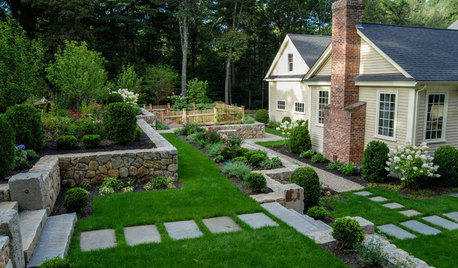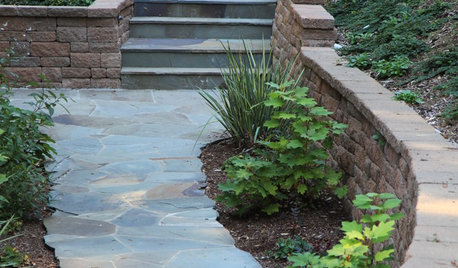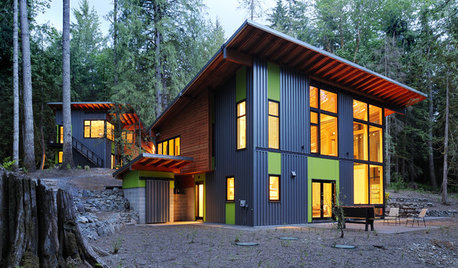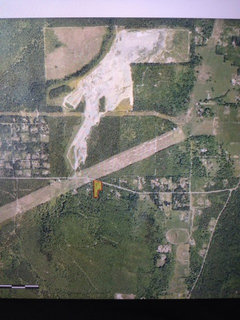How much slope is too much?
olivesmom
11 years ago
Featured Answer
Sort by:Oldest
Comments (19)
virgilcarter
11 years agolast modified: 9 years ago_henry Henry
11 years agolast modified: 9 years agoRelated Discussions
slope of shower bench - is 3/4 in too much?
Comments (2)For a solid, granite seat, 1/4" per foot is the minimum. That's what a pan is sloped to and the water drains just fine. I certainly can't see you needing more than that.........See Morehow much is too much? how much is too little?
Comments (2)Thanks so much, Homebody! Although it has not ALWAYS been FUN, we have really enjoyed this house project. I hope your dream comes true very soon...and cannot wait to see pics of your home too! =) I have enjoyed hearing about this Beadboard Wallpaper. I am wondering if those of you who have used it think it will withstand the MAJOR moisture of our 2 young sons' bathroom??? Is this paintable so it can be sealed? I am worrying what the spattering and running drips of water near the pedestal sink will do to it over time if not 'sealed' with paint???? I am still curious about the 'rules' in my initial question as well as these points about beadboard wallpaper. Thanks for the input =)...See MoreHow much rain is too much?
Comments (15)Tomorrow we start what promises to be the biggest storm in decades. Three to four inches in the Los Angeles basin from mid morning till Saturday afternoon. Should be plenty of flash floods and landslides to go around plus some strong winds will bring soggy trees down. I worked the last big one in February 1979 and got sixty hours of overtime starting on a Thursday night through the middle of the next week. We just cut them so we could move them off the road and a tractor would come later to pick them up....See MoreHow much is too much to spend on a kitchen remodel?
Comments (16)Is this an area of flat ceiling that is 6'5" or does it slant down to 6'5" over part if it. In my location if the lowered portion is over counter areas or fixtures and not in areas where one walks, or is a soffit-type drop that doesn't involve the entire ceiling it is sometimes allowable, although 7' is the minimum ceiling height in kitchens and bathrooms in my location, technically. However I live in an area with extremely old and small housing stock where a kitchen and bath were often added as a lean-to type structure on the back of a house that originally did not have one. Alternately some very large houses with high ceilings (commonly 14') on the first floor were lofted with a kitchen above or below and a bath above or below the loft portion, resulting in two areas of ceiling height of about 6'6". These areas are grandfathered in terms of already preexisting conditions and the envelope is grandfathered allowing a remodeled kitchen or bath in the same space. (As long as the undersized structure is sound). I've done and seen done permitted remodels under these conditions. Because if they weren't permitted, lots of housing stock would be "uninhabitable" and the entire lot size would need to be changed in order to build currently fully compliant housing--many lots are too small to build something compliant. Brand new construction of multiple units often demands the demolition of say 5 houses and replacement with 4. I doubt my situation is applicable in many areas but the point is that existing conditions will be grandfathered locally. This would never fly in someplace like California for example So your locale may grandfather some preexisting conditions if they complied at some past time, to avoid the necessity of complete demolition of a portion of the house. (If the structure is sound, otherwise)....See MoreUser
11 years agolast modified: 9 years ago_henry Henry
11 years agolast modified: 9 years agoLuAnn_in_PA
11 years agolast modified: 9 years agoolivesmom
11 years agolast modified: 9 years agoolivesmom
11 years agolast modified: 9 years agovirgilcarter
11 years agolast modified: 9 years agorrah
11 years agolast modified: 9 years agoolivesmom
11 years agolast modified: 9 years ago_henry Henry
11 years agolast modified: 9 years agovirgilcarter
11 years agolast modified: 9 years agozone4newby
11 years agolast modified: 9 years agoolivesmom
11 years agolast modified: 9 years agorrah
11 years agolast modified: 9 years ago_henry Henry
11 years agolast modified: 9 years agozone4newby
11 years agolast modified: 9 years agoUser
11 years agolast modified: 9 years ago
Related Stories

LANDSCAPE DESIGN11 Design Solutions for Sloping Backyards
Hit the garden slopes running with these bright ideas for terraces, zones, paths and more
Full Story
LANDSCAPE DESIGNHow to Design a Great Garden on a Sloped Lot
Get a designer's tips for turning a hillside yard into the beautiful garden you’ve been dreaming of
Full Story
LANDSCAPE DESIGN10 Creative Ways to Work With a Sloped Lot
A slanted yard may be challenging, but it also provides opportunities for beauty and fun
Full Story
LANDSCAPE DESIGNLandscaping Magic Fixes a Dangerous Sloped Yard
It had scary parking, a confusing entry and erosion issues. See how this steep California landscape gained safety, beauty and clarity
Full Story
GARDENING AND LANDSCAPINGSteeply Beautiful Slope Retention
Don't let things slide or give in to sandbags and cement. These slope retention ideas will keep your landscape hitting the high notes
Full Story
ECLECTIC HOMESHouzz Tour: Problem Solving on a Sloped Lot in Austin
A tricky lot and a big oak tree make building a family’s new home a Texas-size adventure
Full Story
ARCHITECTURESingle-Sloped Roofs Ramp Up Modern Homes
Mirroring a steep site or used for architectural interest, sloped roofs create a connection with the landscape
Full Story
GARDENING AND LANDSCAPINGInspired Designs for Sloped Lots
Get new ideas for outdoor spaces from the lines of your terrain
Full Story
LANDSCAPE DESIGNGarden Levels Transform a Steep Slope in Australia
From unusable to incredible, this outdoor area now has tumbled travertine, water features and mod greenery
Full Story
GARDENING GUIDESGreat Design Plant: Sunrose Dazzles on Dry Slopes
Abundant blooms and attractive foliage make this plant a welcome sight in sunny, well-drained spots
Full Story













olivesmomOriginal Author